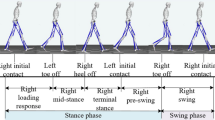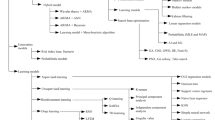Abstract
A kind of support vector machine based optimal control (SVM-OC) approach for minimizing energy consumption of biped walking motions is proposed in this work. Different from existing learning controllers, a SVM controller is incorporated into an optimal controller for biped robots, which aims at minimize an energy-related cost function with three constraints of biped walking robots, including the system dynamics in the single support phase, the system dynamics in the impact phase, and the initial state of the biped. The controller is deduced under the condition of small sample sizes for the SVM. Main contributions of this paper include two aspects: First, a SVM-OC problem for minimizing energy consumption of biped walking motions is defined, which provides new clues to design a kind of optimal controller under the condition of unknown system dynamic model and small sample sizes. Secondly, derivation of the proposed SVM-OC problem is provided in detail, and simulation results demonstrate the advantage of the proposed method compared with conventional SVM control methods and neural network (NN) control methods.
Similar content being viewed by others
Abbreviations
- θ :
-
joint angle
- M:
-
inertia matrix
- V:
-
matrix of centripetal acceleration and Coriolis terms
- G:
-
gravity vector
- τ :
-
input torque vector
- Θ:
-
state vector
- w :
-
weight vector
- ζ i :
-
slack variable
- N :
-
number of the training samples for SVM learning
- i :
-
index of the samples
- C :
-
penalty factor
- φ(·):
-
nonlinear mapping function
- b :
-
bias
- λ 1(t):
-
vector of time-varying Lagrange multipliers
- γ 1 :
-
vector of constant Lagrange multipliers
- γ 2 :
-
vector of constant Lagrange multipliers
- α i :
-
vector of constant Lagrange multipliers
- K :
-
mixed kernel function
- K poly :
-
polynomial kernel function
- K poly :
-
RBF kernel function
- q:
-
degree of the polynomial kernel
- σ :
-
width of the RBF kernel.
- a:
-
mixing coefficient of the mixed kernel
- (y h, zh):
-
the position of the hip joint
- (y a, za):
-
the position of the swinging ankle joint
- p :
-
walking step length
- d :
-
height of swinging ankle
- 2l e :
-
length of lower limbs
- (xzmp, yzmp, 0):
-
coordinate of the zero moment point
References
Sato, T., Sakaino, S., Ohashi, E., and Ohnishi, K., “Walking Trajectory Planning on Stairs Using Virtual Slope for Biped Robots,” IEEE Transactions on Industrial Electronics, Vol. 58, No. 4, pp. 1385–1396, 2011.
Choi, K.-J. and Hong, D., “Posture optimization for a humanoid robot using a simple genetic algorithm,” Int. J. Precis. Eng. Manuf., Vol. 11, No. 3, pp. 381–390, 2010.
Lee, Y.-K. and Lim, D.-W., “An endoskeleton framework biped robot, “ADDAM” with coupled link mechanism,” Int. J. Precis. Eng. Manuf., Vol. 12, No. 4, pp. 613–621, 2011.
Hashimoto, K., Lim, H.-O., and Takanishi, A., “Disturbance Compensation Control for a Biped Vehicle,” Advanced Robotics, Vol. 25, No. 3–4, pp. 407–426, 2011.
Ito, S., Kashima, T., and Sasaki, M., “A biped static balance control and torque pattern learning under unknown periodic external forces,” Engineering Applications of Artificial Intelligence, Vol. 23, No. 7, pp. 1093–1104, 2010.
Kim, J.-H., Kim, J.-Y., and Oh, J.-H., “Adaptive walking pattern generation and balance control of the passenger-carrying biped robot, HUBO FX-1, for variable passenger weights,” Autonomous Robots, Vol. 30, No. 4, pp. 427–443, 2011.
Olensek, A. and Matjacic, Z., “Two-level control strategy of an eight link biped walking model,” Simulation Modelling Practice and Theory, Vol. 19, No. 1, pp. 133–147, 2011.
Collins, S., Ruina, A., Tedrake, R., and Wisse, M., “Efficient bipedal robots based on passive dynamic walkers,” Science, Vol. 307, No. 5712, pp. 1082–1085, 2005.
McGeer, T., “Passive dynamic walking,” International Journal of Robotics Research, Vol. 9, No. 2, pp. 62–82, 1990.
Wisse, M., Feliksdal, G., Van Frankenhuyzen, J., and Moyer, B., “Passive-based walking robot: Denis a simple efficient and lightweight biped,” IEEE Robot. Autom. Mag., Vol. 14, No. 2, pp. 52–62, 2007.
Hurmuzlu, Y., Genot, F., and Brogliato, B., “Modeling, stability and control of biped robots — a general framework,” Automatica, Vol. 40, No. 10, pp. 1647–1664, 2004.
Saidouni, T., and Bessonnet, G., “Generating globally optimised sagittal gait cycles of a biped robot,” Robotica, Vol. 21, No. 2, pp. 199–210, 2003.
Channon, P. H., Hopkins, S. H., and Pham, D. T., “A variational approach to the optimization of gait for a bipedal robot,” Journal of Mechanical Engineering Science, Vol. 210, No. 2, pp. 177–186, 1996.
Rossomando, F. G., Soria, C., and Carelli, R., “Adaptive Neural Dynamic Compensator for Mobile Robots in Trajectory Tracking Control,” IEEE Latin America Transactions, Vol. 9, No. 5, pp. 593–602, 2011.
Bhasin, S., Dupree, K., Patre, P. M., and Dixon, W. E., “Neural Network Control of a Robot Interacting With an Uncertain Viscoelastic Environment,” IEEE Transactions on Control Systems Technology, Vol. 19, No. 4, pp. 947–955, 2011.
Kumar, N., Panwar, V., Sukavanam, N., Sharma, S., and Borm, J.-H., “Neural network based hybrid force/position control for robot manipulators,” Int. J. Precis. Eng. Manuf., Vol. 12, No. 3, pp. 419–426, 2011.
Ferreira, J. P., Crisóstomo, M., and Coimbra, A. P., “Sagittal stability PD controllers for a biped robot using a neurofuzzy network and an SVR,” Robotica, Vol. 29, No. 5, pp. 717–731, 2011.
Kim, H. M., Park, S. H., Lee J. M., and Kim, J. S., “A robust control of electro hydrostatic actuator using the adaptive back-stepping scheme and fuzzy neural networks,” Int. J. Precis. Eng. Manuf., Vol. 11, No. 2, pp. 227–236, 2010.
Muntean, M., Valean, H., Ileana, I., and Rotar, C., “Improving Classification with Support Vector Machines,” Control Engineering and Applied Informatics, Vol. 12, No. 3, pp. 23–33, 2010.
Jeong, S.-H., Choi, D.-H., and Jeong, M., “Feasibility classification of new design points using support vector machine trained by reduced dataset,” Int. J. Precis. Eng. Manuf., Vol. 13, No. 5, pp. 739–746, 2012.
Bayro-Corrochano, E. J. and Arana-Daniel, N., “Clifford Support Vector Machines for Classification, Regression, and Recurrence,” IEEE Transactions on Neural Networks, Vol. 21, No. 11, pp. 1731–1746, 2010.
Ferreira, J. P., Crisostomo, M. M., and Coimbra, A. P., “SVR Versus Neural-Fuzzy Network Controllers for the Sagittal Balance of a Biped Robot,” IEEE Transactions on Neural Networks, Vol. 20, No. 12, pp. 1885–1897, 2009.
Kim, D. W., Seo, S. J., De Silva, C. W., and Park, G. T., “Use of Support Vector Regression in Stable Trajectory Generation for Walking Humanoid Robots,” ETRI Journal, Vol. 31, No. 5, pp. 565–575, 2009.
Suykens, J. A. K., Vandewalle, J., and De Moor, B., “Optimal control by least squares support vector machines,” Neural Networks, Vol. 14, No. 1, pp. 23–35, 2001.
Smits, G. F. and Jordaan, E. M., “Improved SVM regression using mixtures of kernels,” Proceeding of the 2002 International Joint Conference on Neural Networks, Vol. 3, pp. 2785–2790, 2002.
Huang, Q. and Nakamura, Y., “Sensory reflex control for humanoid walking,” IEEE Transactions on Robotics, Vol. 21, No. 5, pp. 977–984, 2005.
Author information
Authors and Affiliations
Corresponding author
Rights and permissions
About this article
Cite this article
Wang, L., Liu, Z., Chen, C.L.P. et al. Support vector machine based optimal control for minimizing energy consumption of biped walking motions. Int. J. Precis. Eng. Manuf. 13, 1975–1981 (2012). https://doi.org/10.1007/s12541-012-0260-7
Received:
Accepted:
Published:
Issue Date:
DOI: https://doi.org/10.1007/s12541-012-0260-7




